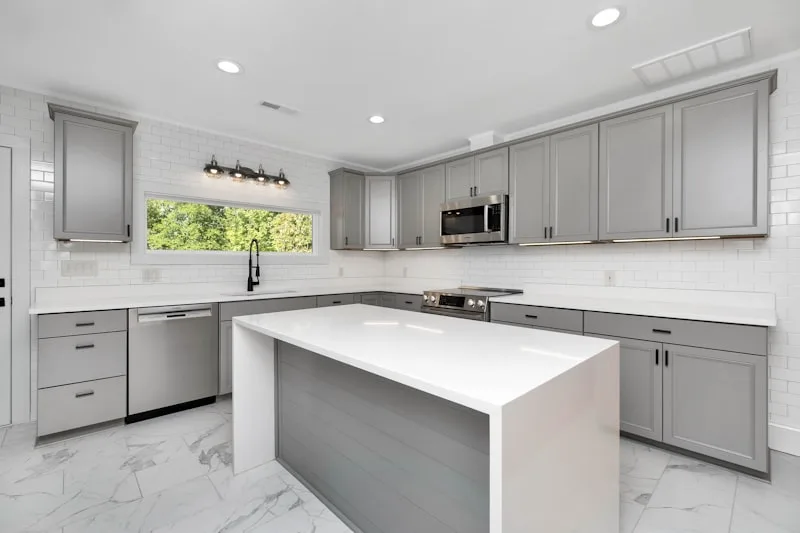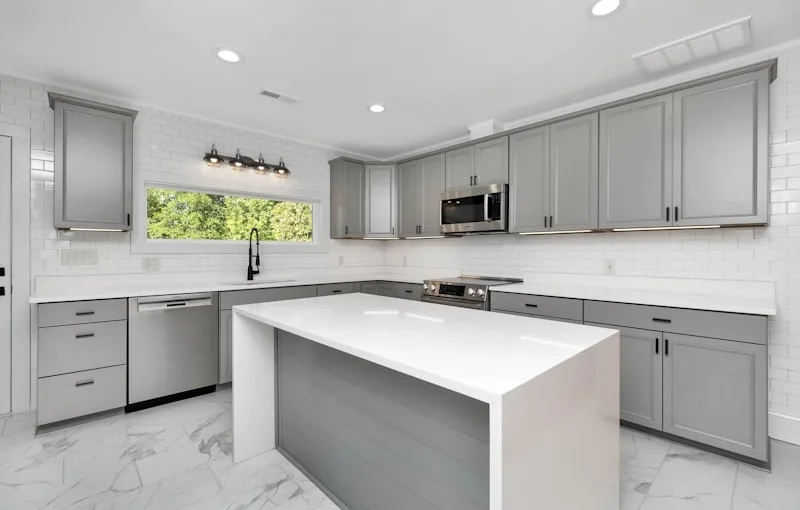Think about it: you’re whipping up a delicious meal, and you need to grab a pot from the cabinet. If the island is too close, you might find yourself doing a little kitchen shuffle, which can be frustrating. On the flip side, if it’s too far away, you might feel like you’re playing a game of “kitchen hopscotch.” Striking that perfect balance is key!
Now, let’s consider the size of your kitchen. In a compact space, you might need to adjust that distance a bit. If you’re working with a smaller kitchen, you can get away with 36 inches, but be cautious—too tight, and you’ll feel cramped. It’s like trying to fit a square peg in a round hole; it just doesn’t work.
Also, think about what you’ll be doing at the island. If it’s primarily for meal prep, you might want a bit more space. But if it’s just a spot for quick breakfasts or casual chats, you can afford to be a little closer. Ultimately, the goal is to create a kitchen that feels open and inviting, where you can move freely and enjoy every moment spent cooking or gathering with loved ones. So, measure wisely and let your kitchen flow!
The Perfect Distance: How Far Should Your Kitchen Island Be from Cabinets?
Generally, a good rule of thumb is to leave about 42 to 48 inches of space between your kitchen island and the cabinets. This distance allows for smooth movement, whether you’re whipping up a gourmet meal or just grabbing a snack. Think of it as giving your kitchen a little breathing room. You want to be able to open cabinet doors and drawers without feeling like you’re in a game of Twister!
But let’s not forget about the size of your island. If you’ve got a larger island, you might want to increase that distance to around 48 inches. It’s like having a spacious dance floor—everyone can move freely without bumping into each other. On the flip side, if your kitchen is on the smaller side, you might be tempted to squeeze things in. Just remember, cramming everything too close can lead to chaos, especially when you have multiple cooks in the kitchen.
Also, consider the flow of your kitchen. If you envision a bustling space where family and friends gather, ensuring ample space between your island and cabinets is crucial. It’s all about creating a harmonious environment where everyone can enjoy the culinary experience without feeling cramped. So, as you plan your kitchen layout, keep that perfect distance in mind—it’s the secret ingredient to a functional and inviting space!
Space Matters: Finding the Ideal Gap Between Your Kitchen Island and Cabinets
First off, let’s talk about the magic number. Ideally, you want to aim for about 42 to 48 inches between your island and cabinets. This isn’t just a random figure; it’s the perfect width for cooking, cleaning, and entertaining. Think of it as the Goldilocks zone—not too tight, not too loose, but just right. If you go too narrow, you’ll be bumping elbows with anyone who dares to enter your culinary kingdom. Too wide, and you might as well be in a different room!
Now, consider your kitchen’s flow. Picture this: you’re whipping up a delicious meal, and your friend is setting the table. If the gap is too small, you’ll both be dodging each other like a couple of clumsy ninjas. But with the right spacing, you can move freely, making your kitchen a hub of activity rather than a bottleneck.
Designing Your Dream Kitchen: The Essential Distance Between Islands and Cabinets
So, what’s the magic number? Ideally, you should aim for at least 42 inches between your kitchen island and the cabinets. This distance is like giving your kitchen a personal bubble, ensuring you have enough room to open cabinet doors, pull out drawers, and even have a couple of friends join you for a cooking session. If you’re planning on having multiple cooks in the kitchen, you might want to stretch that distance to 48 inches. Think of it as giving everyone their own lane on a busy highway.
But it’s not just about space; it’s about functionality. A well-placed island can serve as a prep area, a breakfast bar, or even a gathering spot for family and friends. If it’s too close to the cabinets, you might find yourself playing a game of kitchen Tetris every time you reach for a pot or pan. And let’s be honest, nobody wants to feel like they’re in a cooking obstacle course.
Kitchen Layout 101: Expert Tips on Island and Cabinet Spacing

First off, let’s talk about the kitchen island. Think of it as the heart of your kitchen, where family and friends gather. Ideally, you want at least 42 inches of space around your island. This gives everyone enough room to move around without bumping elbows. Picture it like a dance floor—everyone needs space to groove! If your kitchen is on the smaller side, consider a slim island or a rolling cart that can be tucked away when not in use.
Now, onto cabinets. The golden rule here is to maintain a balance between functionality and aesthetics. You don’t want your cabinets to feel like they’re closing in on you. Aim for at least 15 inches of clearance between the countertop and upper cabinets. This way, you won’t feel like you’re in a cave while cooking. Plus, it allows for easy access to your favorite spices and gadgets without the risk of knocking things over.
And let’s not forget about the work triangle—the relationship between your sink, stove, and refrigerator. Keeping these three elements within a 26-foot triangle can make your cooking experience smoother than a well-blended smoothie.
So, whether you’re a culinary whiz or just love to microwave leftovers, getting your island and cabinet spacing right can transform your kitchen into a functional and inviting space. It’s all about creating a flow that feels natural and effortless, making every meal a joy to prepare.
Avoiding Clutter: The Recommended Clearance Between Kitchen Islands and Cabinets
So, what’s the magic number for clearance? Experts recommend at least 42 inches between your kitchen island and cabinets. This space allows for smooth traffic flow, whether you’re whipping up a gourmet meal or just grabbing a snack. Think of it as giving your kitchen room to breathe. If you have multiple cooks in the kitchen, you might want to stretch that distance to 48 inches. After all, no one wants to bump elbows while sautéing veggies!
Now, let’s talk about functionality. A well-placed island can serve as a prep area, a dining spot, or even a gathering place for family and friends. But if it’s too close to the cabinets, you’ll find yourself constantly dodging corners and bumping into things. It’s like trying to dance in a crowded room—nobody enjoys stepping on toes!
And don’t forget about the appliances! If your island houses a sink or a cooktop, you’ll need extra space to open cabinet doors and pull out drawers without feeling like you’re in a game of Tetris. Picture this: you’re reaching for a pot while someone else is trying to grab a cutting board. Chaos, right?
Maximizing Functionality: How to Measure the Space Between Your Kitchen Island and Cabinets
First off, you want to aim for a comfortable distance. Ideally, you should have at least 42 inches between your island and cabinets. This gives you enough room to open cabinet doors without feeling like you’re in a game of Twister. If you’re planning on having multiple cooks in the kitchen, consider bumping that up to 48 inches. After all, nobody wants to elbow their partner while reaching for a spatula!
Now, let’s talk about the measuring process. Grab a tape measure and start from the edge of your cabinets to the edge of your island. It’s like measuring for a new pair of shoes—too tight, and you’ll be uncomfortable; too loose, and you’ll trip over yourself. Don’t forget to account for any appliances or fixtures that might intrude into that space, like a refrigerator door or a dishwasher.
Also, think about the flow of movement. You wouldn’t want to feel like you’re navigating a maze every time you want to grab a snack. Picture this: you’re cooking up a storm, and you need to dash to the fridge. If the space is too tight, you might find yourself doing a little dance just to get there.
Frequently Asked Questions
What is the ideal distance between a kitchen island and cabinets?
The recommended distance between a kitchen island and surrounding cabinets is typically 42 to 48 inches. This space allows for comfortable movement, easy access to appliances, and sufficient room for multiple people to work in the kitchen without feeling cramped.
How much space do I need for walking around a kitchen island?
To ensure comfortable movement around a kitchen island, allocate at least 42 to 48 inches of clearance on all sides. This space allows for easy access to appliances, cabinets, and the island itself, facilitating smooth traffic flow and usability in the kitchen.
Can I place a kitchen island too close to cabinets?
Placing a kitchen island too close to cabinets can restrict movement and limit functionality. It’s essential to maintain adequate space for opening cabinet doors and drawers, as well as for comfortable traffic flow. A recommended clearance of at least 36 inches is ideal to ensure ease of use and accessibility.
Are there standard measurements for kitchen island spacing?
Proper spacing around a kitchen island is essential for functionality and flow. Ideally, allow at least 42 to 48 inches of clearance on all sides to ensure easy movement and access to appliances. This spacing accommodates multiple users and prevents crowding, enhancing the overall efficiency of the kitchen layout.
What factors affect the distance from cabinets to a kitchen island?
The distance from cabinets to a kitchen island is influenced by several factors, including the overall kitchen layout, the size of the island, the type of cabinetry, and the intended use of the space. Adequate clearance is essential for movement and functionality, typically ranging from 36 to 48 inches, to ensure easy access and workflow efficiency.
